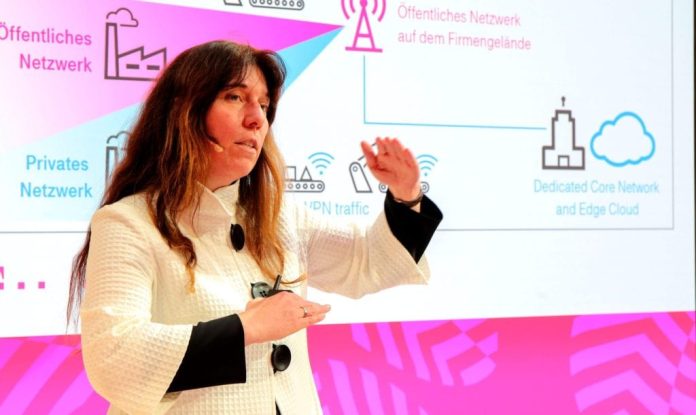Deutsche Telekom told Private Networks Forum yesterday that its role is not to dictate to enterprises about spectrum and technology, but to support every variation of these, and steer enterprises along the way. Decisions about new digital-change tech should be guided by use cases, it said. The firm will work with all new mutations in the telecoms space, even as enterprises take airtime licensing and network management into their own hands.
Speaking on a panel session at the Private Networks Forum event, put on by RCR Wireless and Enterprise IoT Insights, the Germany-based operator suggested the broad enterprise market is too varied to serve with simple cookie-cutter connectivity solutions. Deutsche Telekom is offering so-called ‘campus network’ packages with any combination of public and private LTE and 5G, attached to either national or local (‘vertical’) spectrum licences.
Antje Williams, senior vice president of 5G campus networks at Deutsche Telekom, said industrial enterprises, notably, will benefit from a variety of private/public network infrastructure, in concurrent frequency bands. Deutsche Telekom’s expansion into the 3.6 GHz band in Germany, she noted, works neatly with the local regulator’s liberalisation of 3.7-3.8GHz spectrum for industry.
Deutsche Telekom is offering to build private networks across about 190MHz of spectrum between the blocks, offering local core networks and quality-of-service on public airwaves at 3.6 GHz, and standalone radio and core networks on enterprise-owned licences at 3.7 GHz. The key, as the Industry 4.0 ecosystem expands, is to put everything on the table, implied Williams.
“No one frequency or technology is better than another; you have to look at what it is to be used for.” Licence-exempt technologies like Wi-Fi and Bluetooth will work in concert, and not just in competition, with LTE and 5G in enterprise venues, she made clear. (Hardly revelatory, but notable from a mobile operator, and worth repeating just because the narrative around a total 5G takeover of Industry 4.0 will not die.)
Williams said: “We have a situation right now – [and] maybe you can count the IoT business as the first step [of this], but campus networks represent a second and bigger step – where different industries have to work together. And rightly so. To make [Industry 4.0] successful, we desperately need to talk the same language and understand each other, and also value what each party brings to the table.”
She continued: “From my perspective, no one frequency or technology is better than another. You have to look at what it is to be used for. We might end up with a different mix of technologies – which [might] mean 4G has a right to play, [just] because it is deployed, at least in our footprint, in lower frequencies often [offering] better coverage than the high frequencies [that tend to be used] for 5G – at three-point-something. But you will also see that Wi-Fi will play a role.
“For us, there was a reason to bid for 3.6 GHz spectrum, right under the 3.7-3.8 GHz band, because we can combine the two, which means [customers] can calculate on [around] 190MHz of bandwidth. In the long run, it is going to be important [for enterprises] to have lots of frequency. It is an advantage if you can play with [public and private] spectrum, and with [different technologies like] LTE and 5G. It is a great opportunity for [Deutsche Telekom].”
Williams explained Deutsche Telekom’s offer of dual-slice private/public campus networking. “A lot of customers will need both in the end. [They want] to have a private network they can manage themselves, [especially now] we have private spectrum [for industry] in Germany – which can be used in our [dual-slice] solution for the private network part. In addition, they often want to connect with the public network, to send [data] over [national infrastructure].”
The argument goes that for factory automation with industrial 5G, at least, the need to roam between private and public networks is exaggerated. But Williams, with a direct line into the industrial set in the home of Industrie 4.0, outlined an interesting crossover case for leased factory machinery – “where [enterprises want to allow companies] leasing [industrial machines] to be able to steer machines on their campuses.”
She said: “You need public coverage for that. So sometimes the use cases make it desirable to have both… [But] we also offer a pure public-campus network, meaning you get quality-of-service on top of the public layer, and purely private networks, [which are important] in Germany where [vertical] frequencies have been available for more than a year.”

